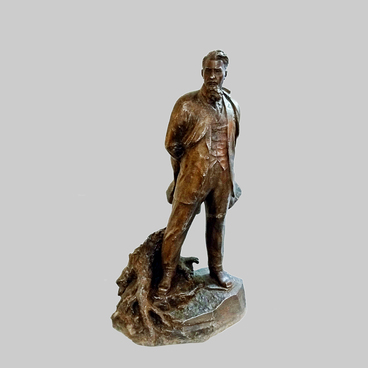The costumes worn in the Southern Urals in the early 20th century were very diverse. This had to do with the region’s multi-ethnic and multi-confessional population, as well as several migration waves from the western part of the country to the Southern Ural lands. This ethno-cultural diversity of the Southern Urals is illustrated by the costume of a Ryazan woman exhibited in the museum. It is an example of the ponyova costumes worn by Russian women. It consists of a shirt, a ponyova (women’s woolen skirt made from several pieces of fabric), an apron, a bib, a waist belt, and a headdress. The ponyova costume is the oldest known form of a traditional Russian women’s outfit. Its images are found in ancient Russian miniatures and icons dating as far back as the 10th century. These costumes began to be gradually replaced by other outfits, primarily apron dresses, in the 14th century. By the 17th century, ponyova costumes were worn only by women in Southern Russia. Apron dresses became popular in the Ryazan Governorate only in the late 17th–early 19th century, and the ponyova skirt remained the main garment of a married woman until the 1920s.
The costume of a married Ryazan peasant woman on display in the museum is made up of elements of two different ponyova costumes that were obtained at different times. The shirt, apron, headdress, and other elements, except for the ponyova, were donated to the museum in 1958 by Daria Zemenkova, who used to live in the village of Degtyanye Borki in the Sapozhkovsky District of the Ryazan Governorate before moving to Chelyabinsk in 1939. The costume was made at the beginning of the 20th century and hasn’t been worn after the 1920s. The costume’s ponyova was in a dilapidated state, so the museum replaced it with a newer one in 1984. The skirt was donated to the museum by T.M. Shokhova from Chelyabinsk. This garment used to belong to A.P. Garakina, a peasant woman from the village of Khrushchovo-Podlesnoe in the Ryazan Governorate. She sewed the ponyova as a dowry for her wedding before the First World War, and later wore it on special occasions.
The costume is part of the exhibit dedicated to the Russian population of the Southern Urals. It is a vivid example of the cultural diversity of not only the numerous peoples living on the territory of the modern Chelyabinsk Region, but also of ethnic groups.
The costume of a married Ryazan peasant woman on display in the museum is made up of elements of two different ponyova costumes that were obtained at different times. The shirt, apron, headdress, and other elements, except for the ponyova, were donated to the museum in 1958 by Daria Zemenkova, who used to live in the village of Degtyanye Borki in the Sapozhkovsky District of the Ryazan Governorate before moving to Chelyabinsk in 1939. The costume was made at the beginning of the 20th century and hasn’t been worn after the 1920s. The costume’s ponyova was in a dilapidated state, so the museum replaced it with a newer one in 1984. The skirt was donated to the museum by T.M. Shokhova from Chelyabinsk. This garment used to belong to A.P. Garakina, a peasant woman from the village of Khrushchovo-Podlesnoe in the Ryazan Governorate. She sewed the ponyova as a dowry for her wedding before the First World War, and later wore it on special occasions.
The costume is part of the exhibit dedicated to the Russian population of the Southern Urals. It is a vivid example of the cultural diversity of not only the numerous peoples living on the territory of the modern Chelyabinsk Region, but also of ethnic groups.



